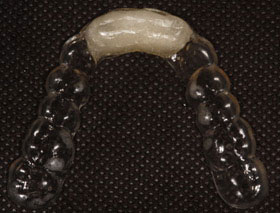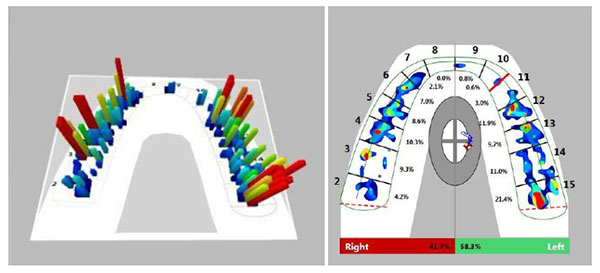
Debilitating migraines are experienced by 39 million Americans and are the sixth most disabling illness in the world. Yet treatment for many sufferers completely ignores the root cause of their symptoms—temporomandibular disorder (TMD), a condition in which the upper and lower jaw are misaligned, a physical ailment that is not obvious to the layman and often goes misdiagnosed.
Migraine headaches usually start in the forehead, the temples, or the back of the head. Those who clench or grind their teeth may also develop migraine-like headaches. Most migraine headaches also have common attributes including tenderness in the jaw, head, neck, and face muscles—or the suboccipital, posterior cervical, medial pterygoid, lateral pterygoid, temporalis, masseter, and trapezius muscles.
“Hot spots” in these muscles, called trigger points, create pain that causes migraine headaches. Myofascial Pain and Dysfunction: The Trigger Point Manual by Dr. David G. Simons, Dr. Janet G. Travell, and Lois S. Simons PT demonstrates muscles, their trigger points, and how they affect different areas when the muscles are hot. While most migraines and TMD headaches have various causes, they all have one thing in common: dysfunction of the temporomandibular joint.
 |
| Figure 2: Extraoral MAGO at first stage of development. |
 |
| Figure 3: Tekscan results. |
The Diagnosis and Treatment
For years, dentists have had to use a large amount of guesswork in diagnosing dental occlusion. Imprecise tools such as articulating paper, waxes, and pressure indicator paste were all we had to assess and balance the forces of the bite with the muscles and joints of the head and neck. Most of these methods are not sensitive enough to detect simultaneous contact, and none measure both biting time and force, which are critical components in diagnosing TMD.
Today, we have a new generation of advanced diagnostic tools to assess and balance bite forces with head and neck muscles and joints. Successful diagnosis and treatment of a patient’s TMD condition requires state-of-the-art technology such as joint vibration analysis, pressure mapping, and force measurement, as well as 3-D x-rays that utilize computerized tests to accurately and objectively measure occlusion.
At the core of successful treatment of TMD-induced migraine headaches is the Maxillary Anterior Guided Orthotic (MAGO), a custom designed, hard acrylic appliance that allows the jaw and neck muscles to realign the lower jaw and stabilize the jaw joints (Figure 1). It is designed to create a temporary even bite and allows the lower jaw and temporomandibular joints to return to their natural and stable position without interference from the teeth, facilitating a definitive dental treatment, that is reversible when MAGO is removed (Figure 2).
Follow-up appointments are needed to adjust the patient’s MAGO. Adjustment visits can be as frequent as once or twice per week, depending on the patient. The MAGO is adjusted with a combination of articulating paper and the Tekscan device. The Tekscan analyzes a patient’s bite and shows what is and what is not functioning properly (Figure 3). The length of time the MAGO is worn varies with the severity and chronic nature of the bite problem and jaw misalignment, but usually the MAGO is worn for two to four months.
When the bite is stable on the MAGO and the joints and muscles are comfortable, a final diagnosis and treatment plan to fix the bite will be developed. After MAGO therapy, permanent treatment of the bite is always necessary to keep the bite stable for the long term.
With MAGO and the array of next-generation diagnostic technology, TMD no longer has to be considered a chronic condition that must be managed over a lifetime. It’s a curable disorder. Most migraine sufferers who experience TMD no longer have to just “grin and bear it.” There’s no need for your patients to continue to live with migraine headache pain when they can get relief from these symptoms naturally and without potentially dangerous prescription drugs.
Dr. Gorman is a highly trained practitioner with more than 40 years of experience in dentistry. He specializes in the treatment of temporomandibular joint dysfunction, sleep disorders, and epigenetic orthodontics. Dr. Gorman is a Diplomate of both the American Academy of Dental Sleep Medicine and American Sleep and Breathing Academy. His office is also an Accredited Facility for the American Academy of Dental Sleep Medicine. He is a certified provider for the ALF as well as the DNA appliance. Dr. Gorman has been an active member of the Lee Institute for Oral Bioesthetics and Function since 1995. Since 1999, he has completed more than 5,000 hours of continuing education in various disciplines of dentistry, including dental sleep medicine, dental implants, bioesthetic dentistry, orthodontics, and temporomandibular joint dysfunction. He can be reached at mgormandental.com.
Related Articles
The 90-Day Window: Trigeminal Nerve Injuries and the Importance of Prompt Referral
Precision Medicine Overcomes Painful TMD Treatment
TMD Treatment May Alleviate Meiniere’s Disease











